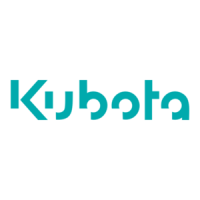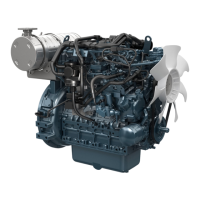
Do you have a question about the Kubota V2403-M-T and is the answer not in the manual?
| Engine Model | V2403-M-T |
|---|---|
| Number of Cylinders | 4 |
| Aspiration | Natural |
| Fuel System | Direct injection |
| Displacement | 2.434 L |
| Rated Power | 42.5 kW (57 hp) at 2600 rpm |
| Lubrication System | Forced lubrication |
| Starting System | Electric |
| Cooling System | Water-cooled |
| Direction of Rotation | Counterclockwise |
| Weight | Approx. 230 kg (507 lbs) |
| Bore x Stroke | 87 mm x 102.4 mm |
General safety warnings using symbols and specific hazard definitions.
Essential preparatory steps before starting any service or repair work.
Procedures and warnings related to starting the engine safely.
Guidelines for safe working practices during engine maintenance and repair.
Precautions to prevent fire hazards related to fuel and batteries.
Recommendations for emergency preparedness, including first aid and contact information.
Procedures for identifying engine model and serial number.
Schedule of regular maintenance inspections based on service intervals.
Detailed procedures for checking and maintaining engine components.
Identifies engine model and serial number for service and parts replacement.
Daily inspection items for engine oil level and coolant.
Maintenance checks required every 50 operating hours, including fuel hoses.
Maintenance checks required every 100 operating hours, including air cleaner and fuel filter.
Maintenance checks required every 150 operating hours, focusing on oil changes.
Maintenance checks required every 200 operating hours, including oil changes.
Maintenance checks required every 400 operating hours, including oil changes.
Maintenance checks required every 500 operating hours, including cooling system cleaning.
Maintenance checks required every 800 operating hours, including valve clearance.
Maintenance checks required every 1500 operating hours, including nozzle condition.
Maintenance checks required every 3000 operating hours, including turbocharger inspection.
Procedures for checking injection pump fuel tightness.
Description of the piston and its skirt coating for noise reduction.
Explanation of the governor's function in maintaining constant engine speed.
Guide for diagnosing and resolving common engine problems.
Technical specifications and allowable limits for engine components.
Specified torque values for various screws, bolts, and nuts.
Procedures for checking, disassembling, and servicing engine components.
Troubleshooting guide for engine body issues when the engine does not start.
Troubleshooting guide for engine deficient output.
Troubleshooting guide for excessive engine oil consumption.
Troubleshooting guide for low engine oil pressure symptoms.
Troubleshooting guide for engine overheating issues.
Troubleshooting guide for a quickly discharged battery.
Troubleshooting for issues related to the electronic governor system.
Servicing specifications for engine body components like valve clearance and compression.
General tightening torque values for standard fasteners.
Specified tightening torques for special use fasteners.
Procedures for checking and adjusting various engine parameters.
Procedures for checking engine body components like compression and valve clearance.
Procedure for measuring and adjusting fuel injection pressure.
Procedure for checking valve seat tightness.
Procedures for checking electronic governor system components.
Procedures for disassembling and assembling engine components.
Procedures for disassembling and assembling cylinder head components.
Procedure for removing and installing the cylinder head.
Procedure for removing and installing the injection pump for non-turbocharged models.
Procedure for removing and installing the injection pump for turbocharged models.
Procedures for disassembling and assembling pistons and connecting rods.
Procedures for removing and installing pistons, including important notes on combination and coating.
Procedures for removing and installing piston rings and connecting rods.
Procedures for checking crankshaft side clearance and alignment.
Procedures for checking cylinder wear and correcting it.
Procedures for checking starter components.
Procedures for checking alternator components.











